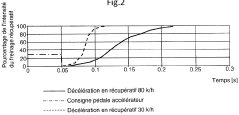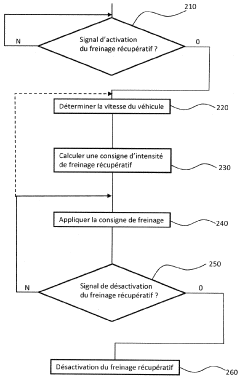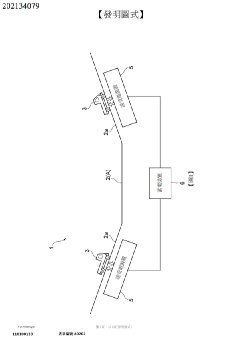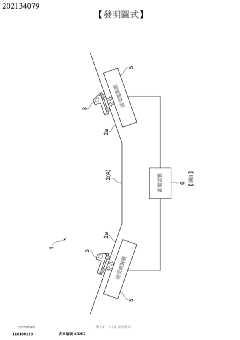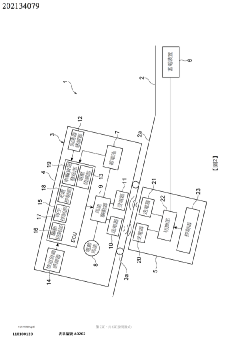Sustainable Urban Mobility Contributions Through Regenerative Braking
AUG 15, 20259 MIN READ
Generate Your Research Report Instantly with AI Agent
Patsnap Eureka helps you evaluate technical feasibility & market potential.
Regenerative Braking Evolution and Objectives
Regenerative braking has evolved significantly since its inception in the early 20th century. Initially developed for electric vehicles, this technology has undergone substantial improvements and adaptations to meet the growing demands of sustainable urban mobility. The primary objective of regenerative braking is to recover and store energy that would otherwise be lost as heat during conventional braking, thereby enhancing overall vehicle efficiency and reducing environmental impact.
The evolution of regenerative braking can be traced through several key stages. In the 1960s and 1970s, the concept gained traction with the rise of hybrid and electric vehicles. However, early systems were limited by inefficient energy storage technologies and rudimentary control mechanisms. The 1990s saw a breakthrough with the introduction of advanced battery technologies and sophisticated power electronics, enabling more effective energy recovery and storage.
In recent years, regenerative braking has become a cornerstone of sustainable urban mobility strategies. Modern systems can recover up to 70% of the kinetic energy that would be lost during conventional braking, significantly improving vehicle range and reducing energy consumption. This efficiency gain is particularly crucial in urban environments, where frequent stops and starts are common.
The objectives of regenerative braking in the context of sustainable urban mobility are multifaceted. Primarily, it aims to reduce overall energy consumption and greenhouse gas emissions from transportation. By recovering and reusing energy, vehicles equipped with regenerative braking systems can achieve higher fuel efficiency or extended electric range, directly contributing to urban sustainability goals.
Another key objective is to enhance the performance and viability of electric and hybrid vehicles in urban settings. Regenerative braking helps address range anxiety by extending battery life and reducing the frequency of charging stops. This improvement in practicality is essential for wider adoption of electric vehicles in urban areas.
Furthermore, regenerative braking systems contribute to the reduction of brake wear and associated particulate emissions. Traditional friction brakes generate fine dust particles that contribute to urban air pollution. By reducing reliance on friction brakes, regenerative systems help mitigate this often-overlooked source of urban environmental degradation.
Looking forward, the evolution of regenerative braking is expected to continue, with objectives focused on further improving energy recovery efficiency, integrating with smart city infrastructure, and adapting to new mobility paradigms such as autonomous vehicles and shared transportation systems. These advancements will play a crucial role in shaping the future of sustainable urban mobility, contributing to cleaner, more efficient, and more livable cities.
The evolution of regenerative braking can be traced through several key stages. In the 1960s and 1970s, the concept gained traction with the rise of hybrid and electric vehicles. However, early systems were limited by inefficient energy storage technologies and rudimentary control mechanisms. The 1990s saw a breakthrough with the introduction of advanced battery technologies and sophisticated power electronics, enabling more effective energy recovery and storage.
In recent years, regenerative braking has become a cornerstone of sustainable urban mobility strategies. Modern systems can recover up to 70% of the kinetic energy that would be lost during conventional braking, significantly improving vehicle range and reducing energy consumption. This efficiency gain is particularly crucial in urban environments, where frequent stops and starts are common.
The objectives of regenerative braking in the context of sustainable urban mobility are multifaceted. Primarily, it aims to reduce overall energy consumption and greenhouse gas emissions from transportation. By recovering and reusing energy, vehicles equipped with regenerative braking systems can achieve higher fuel efficiency or extended electric range, directly contributing to urban sustainability goals.
Another key objective is to enhance the performance and viability of electric and hybrid vehicles in urban settings. Regenerative braking helps address range anxiety by extending battery life and reducing the frequency of charging stops. This improvement in practicality is essential for wider adoption of electric vehicles in urban areas.
Furthermore, regenerative braking systems contribute to the reduction of brake wear and associated particulate emissions. Traditional friction brakes generate fine dust particles that contribute to urban air pollution. By reducing reliance on friction brakes, regenerative systems help mitigate this often-overlooked source of urban environmental degradation.
Looking forward, the evolution of regenerative braking is expected to continue, with objectives focused on further improving energy recovery efficiency, integrating with smart city infrastructure, and adapting to new mobility paradigms such as autonomous vehicles and shared transportation systems. These advancements will play a crucial role in shaping the future of sustainable urban mobility, contributing to cleaner, more efficient, and more livable cities.
Urban Mobility Market Demand Analysis
The urban mobility market is experiencing a significant shift towards sustainable solutions, driven by increasing environmental concerns and the need for efficient transportation in rapidly growing cities. Regenerative braking technology has emerged as a key contributor to this sustainable urban mobility landscape, offering substantial benefits in energy efficiency and reduced emissions.
Market demand for vehicles equipped with regenerative braking systems has been steadily rising, particularly in electric and hybrid vehicles. This growth is fueled by stringent emissions regulations, government incentives for eco-friendly transportation, and growing consumer awareness of environmental issues. Major automotive markets, including China, Europe, and North America, are showing strong adoption rates for vehicles featuring this technology.
In the public transportation sector, there is a growing demand for buses and light rail systems that incorporate regenerative braking. Cities worldwide are investing in upgrading their public transit fleets to more sustainable options, with regenerative braking being a crucial feature in these new vehicles. This trend is particularly pronounced in densely populated urban areas where frequent stops and starts make regenerative braking highly effective.
The micro-mobility market, including e-bikes and e-scooters, is also seeing increased demand for regenerative braking systems. As these modes of transportation gain popularity for short urban trips, consumers are seeking more efficient and longer-lasting battery solutions, which regenerative braking can provide.
Market analysis indicates that the global regenerative braking system market is poised for substantial growth in the coming years. This growth is attributed to the increasing adoption of electric vehicles, stringent fuel efficiency norms, and the push for sustainable urban transportation solutions.
Furthermore, the integration of regenerative braking with other smart city technologies is creating new market opportunities. For instance, the combination of regenerative braking with smart traffic management systems can optimize energy recovery in urban environments, leading to increased demand from city planners and transportation authorities.
The commercial vehicle segment, including delivery vans and trucks operating in urban areas, is another growing market for regenerative braking technology. With the rise of e-commerce and last-mile delivery services, there is an increasing need for energy-efficient vehicles that can operate effectively in stop-and-go urban traffic conditions.
As urban populations continue to grow and cities strive to meet sustainability goals, the demand for technologies that contribute to sustainable urban mobility, such as regenerative braking, is expected to increase significantly. This trend is likely to drive further innovation and investment in the sector, expanding the market for regenerative braking systems across various vehicle types and transportation modes in urban environments.
Market demand for vehicles equipped with regenerative braking systems has been steadily rising, particularly in electric and hybrid vehicles. This growth is fueled by stringent emissions regulations, government incentives for eco-friendly transportation, and growing consumer awareness of environmental issues. Major automotive markets, including China, Europe, and North America, are showing strong adoption rates for vehicles featuring this technology.
In the public transportation sector, there is a growing demand for buses and light rail systems that incorporate regenerative braking. Cities worldwide are investing in upgrading their public transit fleets to more sustainable options, with regenerative braking being a crucial feature in these new vehicles. This trend is particularly pronounced in densely populated urban areas where frequent stops and starts make regenerative braking highly effective.
The micro-mobility market, including e-bikes and e-scooters, is also seeing increased demand for regenerative braking systems. As these modes of transportation gain popularity for short urban trips, consumers are seeking more efficient and longer-lasting battery solutions, which regenerative braking can provide.
Market analysis indicates that the global regenerative braking system market is poised for substantial growth in the coming years. This growth is attributed to the increasing adoption of electric vehicles, stringent fuel efficiency norms, and the push for sustainable urban transportation solutions.
Furthermore, the integration of regenerative braking with other smart city technologies is creating new market opportunities. For instance, the combination of regenerative braking with smart traffic management systems can optimize energy recovery in urban environments, leading to increased demand from city planners and transportation authorities.
The commercial vehicle segment, including delivery vans and trucks operating in urban areas, is another growing market for regenerative braking technology. With the rise of e-commerce and last-mile delivery services, there is an increasing need for energy-efficient vehicles that can operate effectively in stop-and-go urban traffic conditions.
As urban populations continue to grow and cities strive to meet sustainability goals, the demand for technologies that contribute to sustainable urban mobility, such as regenerative braking, is expected to increase significantly. This trend is likely to drive further innovation and investment in the sector, expanding the market for regenerative braking systems across various vehicle types and transportation modes in urban environments.
Regenerative Braking Technology Status
Regenerative braking technology has made significant strides in recent years, becoming a key component in sustainable urban mobility solutions. Currently, this technology is widely implemented in electric and hybrid vehicles, as well as in some advanced conventional vehicles. The primary function of regenerative braking is to recover kinetic energy during deceleration, which would otherwise be lost as heat in traditional friction-based braking systems.
The current state of regenerative braking technology varies across different vehicle types and manufacturers. In electric vehicles (EVs), regenerative braking systems have reached a high level of efficiency, with some models capable of recovering up to 70% of the vehicle's kinetic energy. This recovered energy is then stored in the vehicle's battery, extending the overall driving range and reducing the frequency of charging.
Hybrid vehicles also utilize regenerative braking, although the efficiency is generally lower than in pure EVs due to the complexity of integrating this system with conventional internal combustion engines. Nevertheless, modern hybrid vehicles can still recover a significant amount of energy, typically ranging from 30% to 50% of the kinetic energy during braking.
In terms of technological advancements, recent developments have focused on improving the energy conversion efficiency and the control systems of regenerative braking. Advanced power electronics and more sophisticated motor designs have contributed to higher energy recovery rates. Additionally, the integration of artificial intelligence and machine learning algorithms has enhanced the predictive capabilities of these systems, allowing for more optimal energy recovery in various driving conditions.
One of the main challenges currently facing regenerative braking technology is the balance between energy recovery and driver comfort. Aggressive regenerative braking can provide higher energy recovery but may result in a less smooth driving experience. To address this, manufacturers are developing adaptive systems that can adjust the level of regenerative braking based on driving conditions and driver preferences.
Another area of ongoing development is the integration of regenerative braking with other vehicle systems. For instance, some advanced systems now combine regenerative braking with conventional friction brakes to maximize both energy recovery and stopping power. This integration also extends to vehicle stability control systems, ensuring that regenerative braking does not compromise vehicle handling and safety.
The adoption of regenerative braking technology in public transportation, particularly in buses and light rail systems, has also seen significant progress. These applications often involve more powerful regenerative systems due to the larger vehicle mass and frequent stop-start cycles in urban environments.
While regenerative braking has proven its effectiveness in electric and hybrid vehicles, research is ongoing to expand its application to conventional vehicles with internal combustion engines. This involves the development of more efficient energy storage systems and the integration of mild hybrid technologies to capture and utilize the recovered energy effectively.
The current state of regenerative braking technology varies across different vehicle types and manufacturers. In electric vehicles (EVs), regenerative braking systems have reached a high level of efficiency, with some models capable of recovering up to 70% of the vehicle's kinetic energy. This recovered energy is then stored in the vehicle's battery, extending the overall driving range and reducing the frequency of charging.
Hybrid vehicles also utilize regenerative braking, although the efficiency is generally lower than in pure EVs due to the complexity of integrating this system with conventional internal combustion engines. Nevertheless, modern hybrid vehicles can still recover a significant amount of energy, typically ranging from 30% to 50% of the kinetic energy during braking.
In terms of technological advancements, recent developments have focused on improving the energy conversion efficiency and the control systems of regenerative braking. Advanced power electronics and more sophisticated motor designs have contributed to higher energy recovery rates. Additionally, the integration of artificial intelligence and machine learning algorithms has enhanced the predictive capabilities of these systems, allowing for more optimal energy recovery in various driving conditions.
One of the main challenges currently facing regenerative braking technology is the balance between energy recovery and driver comfort. Aggressive regenerative braking can provide higher energy recovery but may result in a less smooth driving experience. To address this, manufacturers are developing adaptive systems that can adjust the level of regenerative braking based on driving conditions and driver preferences.
Another area of ongoing development is the integration of regenerative braking with other vehicle systems. For instance, some advanced systems now combine regenerative braking with conventional friction brakes to maximize both energy recovery and stopping power. This integration also extends to vehicle stability control systems, ensuring that regenerative braking does not compromise vehicle handling and safety.
The adoption of regenerative braking technology in public transportation, particularly in buses and light rail systems, has also seen significant progress. These applications often involve more powerful regenerative systems due to the larger vehicle mass and frequent stop-start cycles in urban environments.
While regenerative braking has proven its effectiveness in electric and hybrid vehicles, research is ongoing to expand its application to conventional vehicles with internal combustion engines. This involves the development of more efficient energy storage systems and the integration of mild hybrid technologies to capture and utilize the recovered energy effectively.
Current Regenerative Braking Solutions
01 Regenerative braking systems for electric vehicles
Regenerative braking systems in electric vehicles capture and convert kinetic energy into electrical energy during deceleration, improving energy efficiency and extending driving range. These systems are particularly beneficial in urban environments with frequent stop-and-go traffic, contributing to sustainable urban mobility by reducing energy consumption and emissions.- Regenerative braking systems for electric vehicles: Regenerative braking systems in electric vehicles capture and convert kinetic energy into electrical energy during deceleration, improving energy efficiency and extending driving range. These systems are particularly beneficial in urban environments with frequent stop-and-go traffic, contributing to sustainable urban mobility by reducing energy consumption and emissions.
- Integration of regenerative braking with urban transportation systems: Incorporating regenerative braking technology into various urban transportation modes, such as buses, trams, and light rail systems, enhances overall energy efficiency in city mobility networks. This integration helps reduce the carbon footprint of public transportation and supports the development of sustainable urban mobility solutions.
- Advanced control systems for optimizing regenerative braking: Sophisticated control systems are developed to maximize the efficiency of regenerative braking in urban environments. These systems use sensors, algorithms, and real-time data processing to optimize energy recovery based on factors such as vehicle speed, road conditions, and traffic patterns, enhancing the overall performance of regenerative braking systems.
- Energy storage and distribution for regenerative braking systems: Innovative energy storage solutions, such as advanced batteries and supercapacitors, are developed to efficiently store and distribute the energy recovered through regenerative braking. These technologies enable better utilization of recovered energy, supporting the broader implementation of sustainable urban mobility solutions.
- Integration of regenerative braking with smart city infrastructure: Regenerative braking systems are integrated with smart city infrastructure to create a more comprehensive and efficient urban mobility ecosystem. This integration involves connecting vehicles with traffic management systems, charging stations, and other urban infrastructure elements to optimize energy recovery and distribution across the city.
02 Integration of regenerative braking with urban transit systems
Incorporating regenerative braking technology into urban transit systems such as buses, trams, and light rail vehicles enhances energy efficiency in public transportation. This integration helps reduce overall energy consumption, lower operational costs, and minimize environmental impact, supporting sustainable urban mobility initiatives.Expand Specific Solutions03 Energy storage and management for regenerative braking
Advanced energy storage systems and management techniques optimize the use of regenerated energy from braking. These innovations include improved battery technologies, supercapacitors, and intelligent energy distribution systems that enhance the overall efficiency of regenerative braking in urban mobility applications.Expand Specific Solutions04 Adaptive regenerative braking strategies
Intelligent control systems that adapt regenerative braking performance based on driving conditions, vehicle load, and traffic patterns. These adaptive strategies maximize energy recovery while ensuring optimal vehicle handling and safety, contributing to more efficient and sustainable urban transportation.Expand Specific Solutions05 Integration of regenerative braking with smart city infrastructure
Connecting regenerative braking systems with smart city infrastructure enables more efficient energy management across urban transportation networks. This integration allows for better coordination of traffic flow, energy distribution, and charging infrastructure, enhancing the overall sustainability of urban mobility systems.Expand Specific Solutions
Key Players in Sustainable Urban Mobility
The sustainable urban mobility market through regenerative braking is in a growth phase, with increasing adoption across the automotive industry. The market size is expanding as more vehicle manufacturers incorporate this technology into their product lines. Technologically, regenerative braking is maturing, with companies like Hyundai Motor, Kia, GM, and Toyota Industries leading development. These firms are refining the efficiency and performance of regenerative systems. Emerging players such as Ola Electric and Rivian are also contributing to innovation in this space, particularly for electric vehicles. The technology's maturity varies across different vehicle types, with passenger cars at a more advanced stage compared to commercial vehicles.
Hyundai Motor Co., Ltd.
Technical Solution: Hyundai has developed an advanced regenerative braking system for their electric and hybrid vehicles, which significantly contributes to sustainable urban mobility. Their system utilizes a smart regenerative braking control that adapts to driving conditions and driver behavior[1]. The technology employs a combination of motor generators and hydraulic brakes to maximize energy recovery during deceleration. Hyundai's system can recover up to 90% of kinetic energy during braking, which is then stored in the vehicle's battery for later use[2]. This technology is integrated with their eco-driving assistant, which provides real-time feedback to drivers on optimal braking patterns for maximum energy recuperation[3].
Strengths: High energy recovery rate, adaptive control system, integration with driver assistance features. Weaknesses: Complexity may lead to higher maintenance costs, potential for reduced brake feel in some driving conditions.
GM Global Technology Operations LLC
Technical Solution: GM has implemented a sophisticated regenerative braking system across its electric vehicle lineup, focusing on urban mobility applications. Their system utilizes a blended braking approach, seamlessly transitioning between regenerative and friction braking to maximize energy recovery and maintain optimal vehicle control[4]. GM's technology incorporates a variable regenerative braking mode, allowing drivers to adjust the level of regeneration based on traffic conditions and personal preference. The system is capable of capturing up to 70 kW of power during deceleration, significantly extending the vehicle's range in urban environments[5]. Additionally, GM has integrated their regenerative braking system with advanced driver assistance features, such as adaptive cruise control, to further optimize energy recovery in stop-and-go traffic scenarios[6].
Strengths: Customizable regeneration levels, high power capture capability, integration with advanced driver assistance systems. Weaknesses: Potential for reduced brake pedal feel, complexity may increase production costs.
Core Innovations in Energy Recovery
Motor vehicle regenerative braking method
PatentWO2010010283A2
Innovation
- A regenerative braking method that utilizes a computer-controlled system to adjust the intensity of the regenerative braking based on vehicle speed and driver input, using sensors to detect accelerator pedal actions and calculate a setpoint value for the braking action, allowing for adaptive and progressive control of the regenerative braking system.
Regenerative braking system capable of improving the recovery efficiency of energy generated by the regenerative braking when the vehicle is driving downhill
PatentActiveTW202134079A
Innovation
- A regenerative braking system that utilizes a vehicle-mounted electric motor as a generator to convert kinetic energy into electrical energy, which is transmitted to roadside power storage devices for later use by other vehicles, and includes uphill detection to optimize power distribution.
Environmental Impact Assessment
Regenerative braking systems in urban mobility solutions have the potential to significantly reduce the environmental impact of transportation. By capturing and reusing energy that would otherwise be lost during braking, these systems contribute to improved energy efficiency and reduced emissions in urban areas.
The primary environmental benefit of regenerative braking is the reduction in energy consumption. In conventional braking systems, kinetic energy is converted to heat and dissipated into the environment. Regenerative braking, however, converts this kinetic energy into electrical energy, which can be stored and reused to power the vehicle. This process can lead to substantial energy savings, particularly in urban environments where frequent stops and starts are common.
The reduction in energy consumption directly translates to lower greenhouse gas emissions. As vehicles equipped with regenerative braking systems require less energy from their primary power source, whether it be fossil fuels or electricity from the grid, the overall carbon footprint of urban transportation is reduced. This is particularly significant in cities where air quality is a major concern, as lower emissions contribute to improved air quality and reduced health risks for urban populations.
Furthermore, regenerative braking systems can extend the range of electric and hybrid vehicles, making them more viable for urban use. This increased viability can accelerate the adoption of electric vehicles in urban areas, further reducing local emissions and dependence on fossil fuels. The widespread implementation of regenerative braking in public transportation systems, such as buses and light rail, can amplify these environmental benefits on a larger scale.
The environmental impact of regenerative braking extends beyond operational efficiency. The technology can also contribute to reduced wear on traditional friction-based braking systems, leading to less frequent replacement of brake components. This reduction in maintenance requirements translates to fewer resources consumed in the production and disposal of brake parts, further minimizing the overall environmental footprint of urban vehicles.
However, it is important to consider the full lifecycle environmental impact of regenerative braking systems. The production of the additional components required for these systems, such as electric motors and energy storage devices, may have its own environmental costs. A comprehensive assessment should take into account the energy and resources used in manufacturing, as well as the potential for recycling or proper disposal of these components at the end of their life cycle.
In conclusion, while regenerative braking technology offers significant environmental benefits in urban mobility applications, a holistic approach to environmental impact assessment is necessary to fully understand its contributions to sustainable urban transportation systems.
The primary environmental benefit of regenerative braking is the reduction in energy consumption. In conventional braking systems, kinetic energy is converted to heat and dissipated into the environment. Regenerative braking, however, converts this kinetic energy into electrical energy, which can be stored and reused to power the vehicle. This process can lead to substantial energy savings, particularly in urban environments where frequent stops and starts are common.
The reduction in energy consumption directly translates to lower greenhouse gas emissions. As vehicles equipped with regenerative braking systems require less energy from their primary power source, whether it be fossil fuels or electricity from the grid, the overall carbon footprint of urban transportation is reduced. This is particularly significant in cities where air quality is a major concern, as lower emissions contribute to improved air quality and reduced health risks for urban populations.
Furthermore, regenerative braking systems can extend the range of electric and hybrid vehicles, making them more viable for urban use. This increased viability can accelerate the adoption of electric vehicles in urban areas, further reducing local emissions and dependence on fossil fuels. The widespread implementation of regenerative braking in public transportation systems, such as buses and light rail, can amplify these environmental benefits on a larger scale.
The environmental impact of regenerative braking extends beyond operational efficiency. The technology can also contribute to reduced wear on traditional friction-based braking systems, leading to less frequent replacement of brake components. This reduction in maintenance requirements translates to fewer resources consumed in the production and disposal of brake parts, further minimizing the overall environmental footprint of urban vehicles.
However, it is important to consider the full lifecycle environmental impact of regenerative braking systems. The production of the additional components required for these systems, such as electric motors and energy storage devices, may have its own environmental costs. A comprehensive assessment should take into account the energy and resources used in manufacturing, as well as the potential for recycling or proper disposal of these components at the end of their life cycle.
In conclusion, while regenerative braking technology offers significant environmental benefits in urban mobility applications, a holistic approach to environmental impact assessment is necessary to fully understand its contributions to sustainable urban transportation systems.
Policy Framework for Sustainable Transport
The policy framework for sustainable transport plays a crucial role in promoting and implementing regenerative braking systems as a means to enhance urban mobility sustainability. Governments at various levels are increasingly recognizing the potential of this technology to reduce energy consumption, lower emissions, and improve overall transportation efficiency.
At the national level, many countries have incorporated regenerative braking into their broader sustainable transport strategies. These policies often include incentives for manufacturers to develop and integrate regenerative braking systems into vehicles, particularly in electric and hybrid models. Tax credits, subsidies, and research grants are common tools used to encourage innovation and adoption of this technology.
Local governments, particularly in urban areas, are also implementing policies that indirectly support the use of regenerative braking. For instance, the establishment of low-emission zones in city centers encourages the use of vehicles equipped with energy-efficient technologies, including regenerative braking systems. Additionally, some cities have introduced preferential parking or road access for vehicles with advanced energy-saving features.
Public transportation authorities are increasingly mandating the use of regenerative braking in new bus and train acquisitions. This policy approach not only reduces the environmental impact of public transit but also serves as a showcase for the technology, potentially influencing private vehicle owners.
The regulatory landscape is evolving to accommodate and promote regenerative braking technology. Safety standards and performance requirements for regenerative braking systems are being developed and integrated into vehicle certification processes. These regulations ensure that the technology meets specific efficiency and reliability benchmarks.
International cooperation is also shaping the policy framework for sustainable transport technologies like regenerative braking. Cross-border initiatives and agreements, such as those within the European Union, are harmonizing standards and promoting the exchange of best practices in sustainable urban mobility solutions.
However, challenges remain in creating a comprehensive policy framework. The integration of regenerative braking into existing transportation infrastructure requires careful planning and investment. Policies must address not only the technical aspects but also the economic and social implications of widespread adoption.
As the technology continues to advance, policymakers face the task of regularly updating frameworks to keep pace with innovations. This includes addressing emerging issues such as the integration of regenerative braking with smart grid systems and its role in vehicle-to-grid (V2G) technologies.
At the national level, many countries have incorporated regenerative braking into their broader sustainable transport strategies. These policies often include incentives for manufacturers to develop and integrate regenerative braking systems into vehicles, particularly in electric and hybrid models. Tax credits, subsidies, and research grants are common tools used to encourage innovation and adoption of this technology.
Local governments, particularly in urban areas, are also implementing policies that indirectly support the use of regenerative braking. For instance, the establishment of low-emission zones in city centers encourages the use of vehicles equipped with energy-efficient technologies, including regenerative braking systems. Additionally, some cities have introduced preferential parking or road access for vehicles with advanced energy-saving features.
Public transportation authorities are increasingly mandating the use of regenerative braking in new bus and train acquisitions. This policy approach not only reduces the environmental impact of public transit but also serves as a showcase for the technology, potentially influencing private vehicle owners.
The regulatory landscape is evolving to accommodate and promote regenerative braking technology. Safety standards and performance requirements for regenerative braking systems are being developed and integrated into vehicle certification processes. These regulations ensure that the technology meets specific efficiency and reliability benchmarks.
International cooperation is also shaping the policy framework for sustainable transport technologies like regenerative braking. Cross-border initiatives and agreements, such as those within the European Union, are harmonizing standards and promoting the exchange of best practices in sustainable urban mobility solutions.
However, challenges remain in creating a comprehensive policy framework. The integration of regenerative braking into existing transportation infrastructure requires careful planning and investment. Policies must address not only the technical aspects but also the economic and social implications of widespread adoption.
As the technology continues to advance, policymakers face the task of regularly updating frameworks to keep pace with innovations. This includes addressing emerging issues such as the integration of regenerative braking with smart grid systems and its role in vehicle-to-grid (V2G) technologies.
Unlock deeper insights with Patsnap Eureka Quick Research — get a full tech report to explore trends and direct your research. Try now!
Generate Your Research Report Instantly with AI Agent
Supercharge your innovation with Patsnap Eureka AI Agent Platform!


